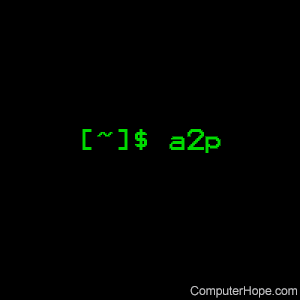Linux a2p command
Updated: 11/06/2021 by Computer Hope

The a2p utility takes an awk script specified on the command line and produces a comparable perl script on standard output.
Syntax
a2p [options] [filename]
Options
| -D<number> | Sets debugging flags. |
| -F<character> | Tells a2p that this awk script is always invoked with this -F switch. |
| -n<fieldlist> | Specifies the names of the input fields if input does not have to be split into an array. If you were translating an awk script that processes the password file, you might say:a2p -7 -nlogin.password.uid.gid.gcos.shell.homeAny delimiter can be used to separate the field names. |
| -<number> | Causes a2p to assume that input always have that many fields. |
| -o | Tells a2p to use old awk behavior. The differences are:
print sprintf(some_args), extra_args;old awk considers extra_args to be arguments to sprintf; new awk considers them arguments to print. |
Considerations
a2p cannot do as good a job translating as a human would, but it usually does pretty well. There are some areas where you may want to examine the perl script produced and tweak it some. Here are some of them, in no particular order.
- There is an awk idiom of putting int() around a string expression to force numeric interpretation, even though the argument is always an integer. This is generally unneeded in perl, but a2p can't tell if the argument is always going to be integer, so it leaves it in. You may want to remove it.
- Perl differentiates numeric comparison from string comparison. Awk has one operator for both that decides at run time which comparison to do. A2p does not try to do a complete job of awk emulation at this point. Instead it guesses which one you want. It's often right, but it can be spoofed. All such guesses are marked with the comment ""#???"". You should go through and check them. You might want to run at least once with the -w switch to perl, which will warn you if you use == where you should have used eq.
- Perl does not attempt to emulate the behavior of awk where nonexistent array elements spring into existence by being referenced. If somehow you are relying on this mechanism to create null entries for a subsequent for...in, they won't be there in perl.
- If a2p makes a split line that assigns to a list of variables that looks like (Fld1, Fld2, Fld3...) you may want to rerun a2p using the -n option mentioned above. This lets you name the fields throughout the script. If it splits to an array instead, the script is probably referring to the number of fields somewhere.
- The exit statement in awk doesn't necessarily exit; it goes to the END block if there is one. Awk scripts that do contortions in the END block to bypass the block under such circumstances can be simplified by removing the conditional in the END block and exiting directly from the perl script.
- Perl has two kinds of array, numerically-indexed and associative. Perl associative arrays are called "hashes". Awk arrays are usually translated to hashes, but if you happen to know that the index is always going to be numeric you could change the {...} to [...]. Iteration over a hash is done using the keys() function, but iteration over an array is NOT. You might need to modify any loop that iterates over such an array.
- Awk starts by assuming OFMT has the value %.6g. Perl starts by assuming its equivalent, $#, to have the value %.20g. You'll want to set $# explicitly if you use the default value of OFMT.
- Near the top of the line loop will be the split operation that is implicit in the awk script. There are times when you can move this down past some conditionals that test the entire record so that the split is not done as often.
- For aesthetic reasons you may want to change index variables from being 1-based (awk style) to 0-based (Perl style). Be sure to change all operations the variable is involved in to match.
- Immature comments such as "# perl is better than awk" are not modified, and pass through as-is.
- Awk scripts are often embedded in a shell script that pipes stuff into and out of awk. Often, the shell script wrapper can be incorporated into the perl script since perl can start up pipes into and out of itself, and can do other things that awk can't do by itself.
- Scripts that refer to the special variables RSTART and RLENGTH can often be simplified by referring to the variables $`, $& and $', as long as they are within the scope of the pattern match that sets them.
- The produced perl script may have subroutines defined to deal with awk's semantics regarding getline and print. Since a2p usually picks correctness over efficiency. It is almost always possible to rewrite such code to be more efficient by discarding the semantic sugar.
- For efficiency, you may want to remove the keyword from any return statement that is the last statement executed in a subroutine. a2p catches the most common case, but doesn't analyze embedded blocks for subtler cases.
- ARGV[0] translates to $ARGV0, but ARGV[n] translates to $ARGV[$n-1]. A loop that tries to iterate over ARGV[0] won't find it.
Examples
a2p myfile.awk
This command will read the file myfile.awk and output the perl version of the same script to standard output. To write the output to a file, use the following command:
a2p myfile.awk > myfile.pl
Related commands
awk — Interpreter for the AWK text processing programming language.
perl — Interpreter for the Perl programming language.
s2p — Convert a sed script into a Perl script.
sed — A utility for filtering and transforming text.
